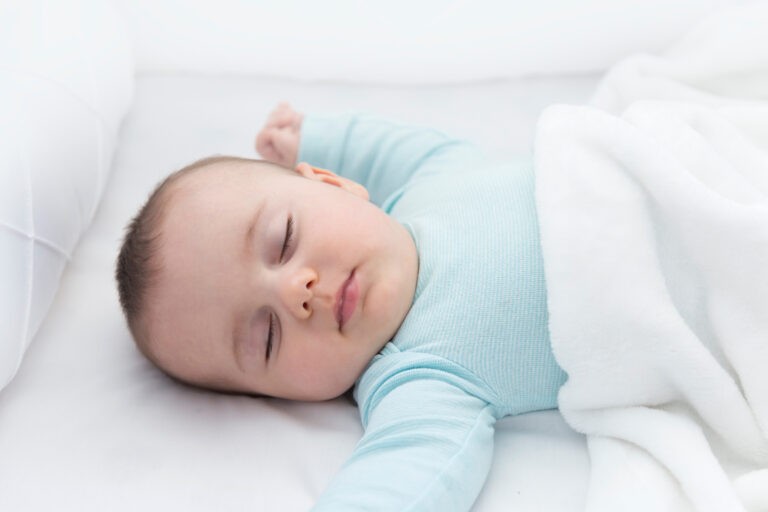A baby’s smile is a heartwarming milestone for parents and caregivers. Beyond the delightful smiles observed when they are awake, many notice their babies smiling in their sleep and naturally wonder about the reasons behind these serene expressions.
It’s perfectly normal for babies to smile during sleep, and this phenomenon is well-documented by sleep experts. While a newborn’s smile is often considered more of a reflex, as babies develop, those sleepy smiles can evolve into something that seems dream-induced and more genuine.
Let’s explore the fascinating world of infant sleep smiles, delving into when babies begin to smile and the various reasons why these enchanting expressions occur during their slumber.
Reasons Behind Babies Smiling in Their Sleep
Pinpointing the exact reasons why babies smile in their sleep remains a subject of ongoing research. Current evidence suggests a mix of factors, and the explanations may differ based on a baby’s age and their sleep stage.
REM Sleep and Dream-like Activity
The majority of sleep smiles in newborns appear to coincide with Rapid Eye Movement (REM) sleep, also known as active sleep. This is the sleep stage associated with dreaming. Studies indicate that adults often smile when experiencing positive dream content. While we can’t know for sure if babies dream in the same way or experience the same dream emotions, REM sleep is a key factor in understanding these smiles.
The sleep cycle of newborns is different from adults and includes three stages: quiet sleep, indeterminate sleep, and active sleep. Active sleep is the counterpart to adult REM sleep, the stage when dreaming predominantly occurs. During REM sleep, brain activity increases, rapid eye movements occur beneath closed eyelids, and the body experiences temporary muscle paralysis to prevent acting out dreams.
However, a significant difference is that infants are not fully paralyzed during active sleep. In this stage, a baby might exhibit twitches, sucking motions, limb movements, and, notably, smiles or frowns. Researchers have even observed that newborns can display complex facial expressions during REM sleep, sometimes even before they demonstrate these same expressions while awake. Therefore, a baby’s very first smile might indeed happen during sleep.
Older research has described these infant sleep smiles as reflex-like. Studies indicate that smiles during active sleep originate in the cerebral cortex, the brain’s outer layer. It is believed that these spontaneous sleep smiles might play a role in developing the muscles used for smiling and pave the way for more intentional smiling and laughter as the child grows.
Are Baby Smiles or Laughs During Sleep Ever a Concern?
In rare instances, a baby’s laugh during sleep might be related to a condition called gelastic seizures. Gelastic seizures are an extremely uncommon type of seizure that can cause uncontrollable laughter, though usually without the genuine emotion of amusement. Notably, about one-third of individuals with gelastic seizures experience their first episode during infancy.
These seizures can occur as an infant is drifting off to sleep. If a gelastic seizure happens during sleep, the baby might briefly awaken and then fall back asleep once it subsides. Gelastic seizures are typically short, lasting only 10 to 20 seconds, and may be accompanied by other signs such as squirming, grunting, or lip smacking.
It’s crucial for caregivers to consult their pediatrician if they observe any concerning symptoms in their baby. A pediatrician can provide guidance and, if necessary, recommend a specialist for further evaluation.
The Timeline of Baby Smiles: When Do They Start?
Babies may smile shortly after birth, but these newborn smiles are usually reflexive, triggered by internal physical sensations like gas or hunger. This differs from an adult’s smile, which is primarily a communication of pleasure and emotion. Experts are uncertain if a newborn’s smile carries emotional meaning in the same way.
Generally, a newborn baby’s facial expressions might not reflect the same emotions as similar expressions in adults. For instance, a newborn might appear to laugh when actually distressed, or they might raise their cheek muscles as a reflex to touch. Even in older infants up to one year old, smiles don’t always equate to happiness.
The first true “social smile” typically emerges when babies are around 2 months old. This type of smile is a deliberate interaction with caregivers. Social smiles develop around the same time as other emotional facial expressions.
Once babies learn to smile socially, it becomes a powerful tool for communication. Initially, social smiles might occur without direct eye contact, which is normal. Over time, babies develop the ability to maintain eye contact during these interactions.
When a newborn smiles during REM sleep, experts usually consider it a spontaneous, rather than a social, smile. These spontaneous smiles often involve a closed mouth. In contrast, social smiles, which appear when a baby is awake, are typically open-mouthed and considered more genuine expressions of interaction and joy. However, some research has noted social-type smiles even during active sleep.
How to Encourage Your Baby to Smile
Creating a loving and responsive environment can encourage a baby’s first smiles. While babies reach developmental milestones, including smiling, at their own pace, consistent nurturing plays a significant role.
A baby’s smile is a vital social tool for expressing positive emotions and building bonds with caregivers. Babies are highly attuned to caregiver attention, and a smile can be their way of responding. Primary caregivers and siblings often receive more smiles, while extended family and friends might need to wait for the baby to become more comfortable.
Responding to a baby’s smiles and consistently meeting their needs fosters a sense of security and confidence, laying the foundation for future social skills. Babies are also sensitive to caregiver emotions; research shows that babies smile and laugh less when their caregivers are experiencing depression or anxiety.
Here are some ways to encourage your baby to smile:
- Make playful faces or stick out your tongue.
- Smile at your baby frequently.
- Sing or speak in a gentle, high-pitched voice.
- Gently tickle your baby.
In a broader sense, smiling in babies is often linked to sleep quality. Research suggests that babies who smile and bond with parents at bedtime may also experience better sleep due to an enhanced sense of trust and security. Bedtime routines that promote bonding, such as singing lullabies, feeding, or cuddling, are beneficial. Interacting with a sleeping infant, however, is unlikely to directly elicit more smiles.
It’s important to remember that every baby develops at their own rhythm. If your baby is not smiling by 3 months old, if they are missing other milestones, or if you have any other concerns, it is always wise to discuss this with your pediatrician.
Still have questions? Ask our community!
Join our Sleep Care Community — a trusted hub of sleep health professionals, product specialists, and people just like you. Whether you need expert sleep advice for your insomnia or you’re searching for the perfect mattress, we’ve got you covered. Get personalized guidance from the experts who know sleep best.


